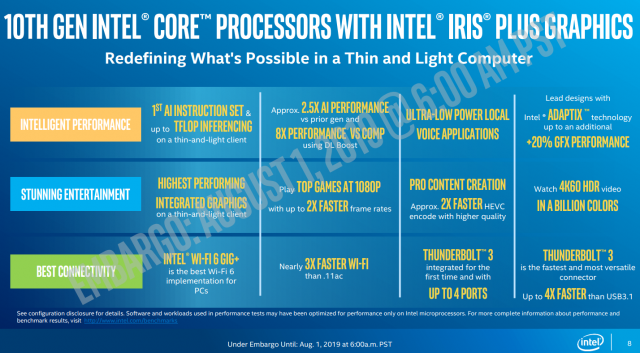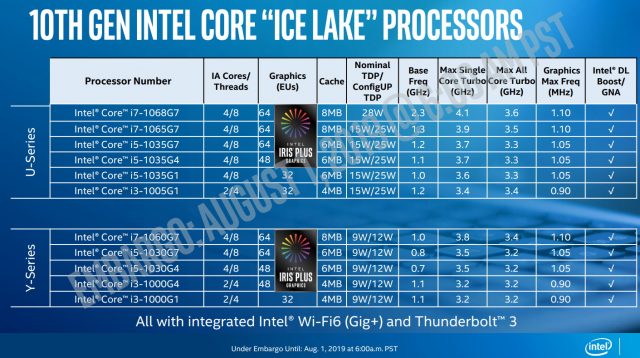Intel Reveals Clock Speeds, GPU Specs for 10nm Ice Lake Mobile SoCs
Last week, Intel announced that it had begun shipping 10nm Ice Lake CPUs to its OEM customers to support a holidays 2019 launch. Today, the company is sharing more details about Ice Lake and the new chips it will launch on 10nm later this year. The company has been revealing details about Ice Lake and its architecture, Sunny Cove, since Architecture Day last winter. As “Holidays 2019” draws closer, we’re starting to find out more information.
With 10nm, Intel is pushing forward on multiple fronts. CPU-wise, the company expects to offer up to 1.18x improved IPC, though that gain is largely offset by declines in top-end frequency. Intel’s own slides show a relatively small gain in terms of raw performance over and above Whiskey Lake, though users with older systems based on Broadwell or Skylake will see much larger improvements.

Ice Lake packs a grab bag of improvements intended to appeal to multiple different markets. Boosted AI inferencing performance is potentially appealing to those working in the field, though I’m not sure if any practical applications actually use AI or AVX-512 on the desktop yet. Faster Wi-Fi via 802.11ax, aka Wi-Fi 6, should boost download speeds. Thunderbolt 3 is not integrated on-die with Intel Ice Lake, though actually offering that connectivity to customers will still require a degree of external hardware and is therefore somewhat dependent on OEMs to make available. Intel has stated, however, that the costs and amount of external components will be smaller than usual.
Mobile GPU performance is said to be significantly stronger, courtesy of a wider GPU core and more efficient execution. Ice Lake will support either dual-channel DDR4-3200 or LPDDR4X-3733 in four 32-bit channels. Overall power consumption is said to be similar between both standards, though the LPDDR4X systems will top out at 32GB, while the DDR4-3200 rigs will support up to 64GB. Our slideshow on the Sunny Cove architecture and the various improvements baked into the core is presented below:
One new bit of data Intel is revealing today is the actual SKUs and products. Here’s the lineup of 10th Generation mobile parts, with data on their wattage envelopes, clocks, and GPU configurations.

Let’s start with the 28W CPU. The best comparison to that is the Core i7-8569U, a 28W 4C/8T CPU with a 2.8GHz base clock, 4.7GHz boost clock, and 128MB of onboard EDRAM to improve the performance of its integrated Iris Plus Graphics 655 solution. We will immediately grant that we expect Gen 11 Intel graphics to be faster than the EDRAM-boosted solutions the company has used before. We also note that the 10nm Ice Lake Core i7-1068G7 supports faster RAM (DDR4-3200 / LPDDR4-3733 as compared to DDR4-2400). Intel CPUs typically haven’t benefited as much from faster RAM clocks as AMD CPUs, but the fact that Intel is increasing its RAM clock suport with 10nm may mean this has changed.
Both CPU and GPU maximum frequencies have declined. The Core i7-8569U has a maximum GPU frequency of 1.2GHz, while the Core i7-1068G7 supports a maximum frequency of 1.1GHz. Base frequency for the 10th Generation core CPU has dropped 18 percent. Since we know that Intel TDPs are based solely on boost clocks, the implication is that the company had to give up base clock to make its TDP figures.
The 15W minimum frequencies have also come down. The Core i7-1065G7 has a base frequency of 1.3GHz, while the comparative Core i7-8665U is a 1.9GHz CPU with a 4.8GHz base clock. That’s a 32 percent reduction in minimum frequency. I don’t want to sound negative on Ice Lake before we see the chips. It’s possible that some of the clock pulldown has been to make room for the GPU. But this is a point we’ll be watching closely — Intel may have had to strike a difficult balance between allocating TDP for CPU versus GPU operations.
Word from Intel is that Ice Lake will be built on a 10nm+ process, which puts that question to rest. The little-used Cannon Lake Core i3-8121 will evidently be the sole representative of Intel’s base 10nm process. 10nm+ will debut with Ice Lake. Whether Intel has a 10nm++ process in the works or will proceed directly to 7nm for future CPUs isn’t something the company has disclosed yet.
For more on this and some initial benchmarks, read PCMag’s Intel ‘Ice Lake’ Benchmarked: How 10nm CPUs Could Bring Major GPU Grunt to New Laptops.


